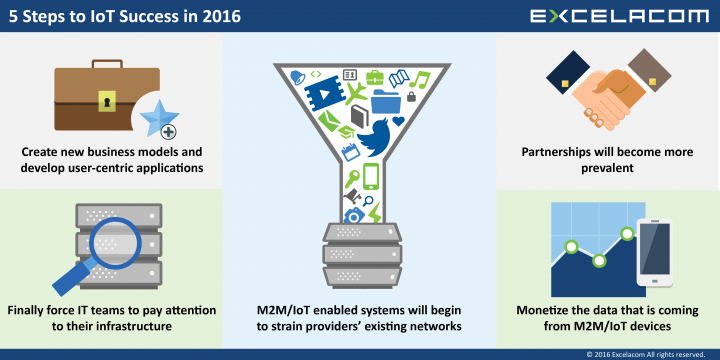Blogs
IoT
This article first appeared in RCRWireless News.
Excelacom Sees 5 Steps to IoT Success in 2016
The "Internet of Things" is here and it's moving quickly. Market forecasts aside, you only need to look around to see connected devices in play – smart meters from utilities, smart traffic lights and parking spaces used by municipalities, smart water management systems used by agriculture, golf courses and others, pressure and flow monitoring systems in the oil and gas industries … the list goes on and on. On the consumer side, the results have been the same: smartwatches, smart thermometers, connected cars and the like are beginning to transform the way people live their day-to-day activities.
The key to making the IoT hum is connectivity and, for that reason, communications service providers have become an indispensable part of the machine-to-machine/IoT ecosystem. The challenge for 2016 and beyond is how to leverage their role and monetize it to become the owner of the M2M/IoT ecosystem – the king of the hill, so to speak.

Can they get this done? If so, how? There are five predictions for CSPs in 2016, as they look to cement their M2M/IoT identities:
1. Service providers will truly embrace M2M/IoT – not because it's a trend, but because it will allow them to generate new revenue streams by monetizing existing network assets in a brokered ecosystem and reducing cost. But to truly find success, they will need to create new business models and develop innovative and user-centric applications.
Expect more service providers to enter the M2M/IoT arena by establishing separate business units with dedicated personnel to focus on the unique characteristics of M2M/IoT solutions. As part of this, they will bring to market flexible solutions that accommodate different technologies and system architectures that incorporate connectivity, integration services and application development.
2. The new demands put on networks by M2M and IoT will finally force IT teams to pay attention to their infrastructure – and take steps to optimize it. For a long time, service providers have adopted a "if it ain't broke, don't fix it" mentality. If it's worked thus far, why won't it work going forward?
We know the answer – M2M/IoT is a whole different beast, and legacy infrastructure will be put to the test to keep up with the velocity and volume of M2M/IoT traffic. Legacy infrastructures are also expensive and difficult to maintain. The necessity for change is simple: stay ahead of the age profile and technology curve while maximizing infrastructure utilization, before the system starts to break down. Infrastructure optimization should not only include servers, network and storage infrastructure, as well as data center infrastructure, such as power, cooling and floor space.
With constant growth and expanding business ventures increasing exponentially, infrastructure optimization is becoming a requirement. As a result, companies will be able to experience quicker time to market, cut operational and maintenance costs, and more importantly develop an ongoing process that will sustain optimal infrastructure configurations for the future.
3. The massive growth of M2M/IoT enabled systems will begin to strain providers' existing networks, and we'll begin to see more and more providers talking about the need for a new network devoted solely to M2M and IoT traffic. Infrastructure optimization comes into play here as well; if the old, yet optimized, network is still not robust enough to keep up with demand, some carriers may begin to make plans – or create partnerships – to create a network specific to M2M/IoT traffic. That will create its own challenges and providers need to understand the strategy and benefits for taking this route.
4. Services providers will realize they can't go it alone, and partnerships will become more prevalent between mobile network operators, mobile virtual network operators, satellite providers, companies with low-power wide-area solutions, solutions integrators and others to present more robust, seamless connectivity options to their customers.
The market is too big and complex for service providers to go at it alone, especially while business models are in flux. Partnerships can help spread risk and test innovation. Vertical partnerships can help enhance service capabilities and create new business models that better suit the emerging market. In addition, partnerships can help fill in the gaps in a provider's strategy, supporting for example the M2M/IoT requirements of multinational organizations that want to deploy M2M/IoT solutions across regional networks.
5. At a higher level, service providers will need to take a close look at how to monetize the data that is coming from M2M/IoT devices. Data gathered through M2M/IoT initiatives will enable service providers to develop marketing and sales strategies that leverage analytics, monitoring and real-time reporting to help them differentiate their offering through customized programs and campaigns. It will also provide a historical perspective to monitor for trends and forecasting.
All of these predictions will force service providers to look carefully at their business, technology and operational strengths and challenges, and implement a top-to-bottom business strategy that accounts for optimization of organizational structure, billing systems, pricing, partnerships and networks. The goal of owning the M2M/IoT ecosystem isn't far-fetched if providers can overcome the challenges that lie in their paths.
For more information on how Excelacom can help you find IoT success, contact us at marketing@excelacom.com